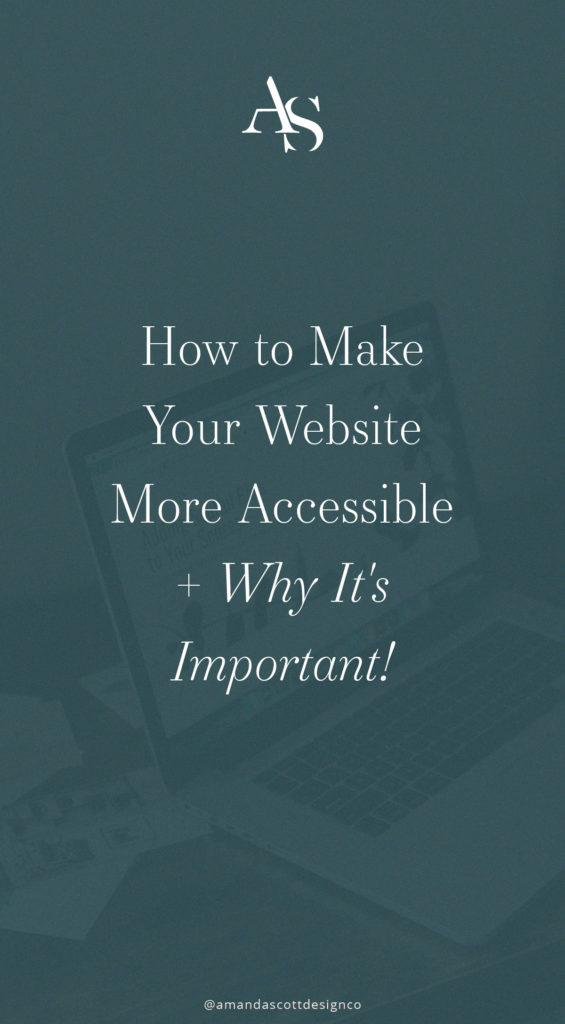As we spend more time online working, shopping, or just scrolling through social media, it’s becoming more and more important to make the online world just as accessible as any other public place. If you don’t know what accessibility is, the Americans with Disabilities Act passed in 1990 stated that every public place should be accessible to those with disabilities (among other things). Since the internet has become more and more important in our everyday lives, it has actually been argued that it’s a public utility.
As a business owner, you may be wondering how this applies to you. In today’s post, I’ll cover what exactly it means to be accessible, why it’s important to you as a business owner, and what steps you can take to make sure your website is accessible.

What is accessibility?
We’ve seen more and more accessibility options come out in the last few years as more people interact online because of the pandemic. Instagram for example, added the ability to add captions to your stories so if someone has hearing issues they can still read and understand what you’re talking about. But things like that go beyond just helping people with disabilities. It also gives people the option of HOW they want to consume their content. Some people like listening to content, others like reading, and others need to watch to learn from you. Keeping accessibility in mind allows people to interact with you in the ways that they learn best and the way they want to.
But when we talk about website accessibility, it means that you are building your website with accessibility in mind so others with hearing or vision impairments can still consume your content, hire you, and choose to be a part of your community. I’ll dig into how to make that happen a little later in this post.
Why is accessibility important as a business owner?
Did you know that you can actually be sued if your website isn’t accessible? That’s right. In fact, this guy did it– and won. Robles is a blind man who just wanted to order a pizza from Dominos, but couldn’t because their website was not accessible. Back in 2019, the Supreme Court ruled that Robles was right in suing the company. Since then, Dominos has made its site much more accessible.
Now I know what you’re thinking, “I’m not a big corporation like Dominos so I won’t be sued.” That’s probably true, honestly. Only public institutions like universities are subject to fines if they do not make their websites accessible.
But does that mean that you shouldn’t make your website accessible? Sure, if you want to be a jerk and potentially lose business. There are an estimated 295 million people in the world with moderate to severe vision impairment alone. I don’t know about you, but I think those people should be able to read and interact with your website.
How you can make your website more accessible.
I’m sure by now you may be wondering how you can actually start integrating more accessibility concepts into your business, and into your website.
As a brand and website designer, I actually keep accessibility concepts in mind when I’m creating color palettes, choosing fonts, and creating brand guides for my clients, and they don’t even know it. If you’re considering working with a designer, you may want to consider asking them if they are familiar with the accessibility concepts.
Now keep in mind, I’m not an expert on accessibility. I do know a decent amount from back in my corporate days when we had to redesign the entire website and make it more accessible (I’m talking thousands of pages, ya’ll.) There are entire guidelines of how to make your website more accessible here. If you adhere to Web Content Accessibility Guidelines (WCAG) AA, you’ll be in great shape. To break it down for you, here are the basics of what you need to consider when designing an accessible website:
Color Contrast
Probably the biggest thing I see that people (even professional designers) do wrong is having enough contrast between the colors they use. WCAG 2.0 level AA requires a contrast ratio of at least 4.5:1 for normal text and 3:1 for large text. To check the contrast ratio, you can use a tool like this to see if you have enough contrast between the two colors that you’re using for your text and graphics.
Minimum font sizes
The general rule of thumb is body copy should be no smaller than 16px on a desktop, 12px on a mobile device. If you do go smaller, make sure it’s only for small bits of text and using a font that is easily readable. The rest of your headlines and subheads should follow a normal hierarchy when it comes to choosing their size. Be sure to check your font sizes on the actual device too! That will help make sure that you are choosing the correct size.
Using raw text and not images of text.
If you want to know what my #1 pet peeve is on websites, it would probably be this. Don’t “bake” your text into an image to try to get just the right layout. When you add text to an image and upload it to your site, screen readers aren’t able to read it as text, which is a problem for people with sight issues. In addition, this is bad for SEO because Google is also not able to tell that you have text in your image, and it’s likely missing some important information about your site.
Navigating your site using the tab key
Some people aren’t able to use a traditional mouse or trackpad so they have to use their tab button to navigate through a website. A simple test of this is to open up your website and just start hitting your own tab key. What do you notice? Can you tell what is highlighted? Does it jump around in a way that doesn’t make sense? If not, then you’ll need to go into the backend of your site to try to organize it in a way that will make more sense. Making sure a user can tab through your site is important for navigation!
Add alt text to images
Adding Alt text to images allows screen readers to be able to communicate what the photos are on a website. This allows for a better experience for anyone that may have vision issues. Not only that, but adding in alt text also helps search engines and can help with SEO (but that shouldn’t be the focus!)
Hopefully this post was helpful in helping you know more about accessibility and how you can apply it to your own website. And if you want more tips on what info about what type of things your website should have, be sure to grab a copy of my Website Essentials Checklist. Of course, it’s free!
